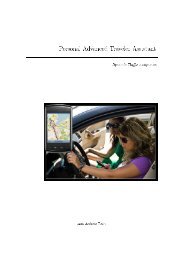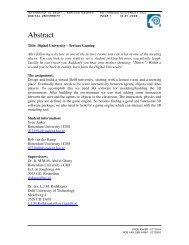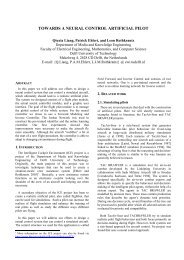Recognition of facial expressions - Knowledge Based Systems ...
Recognition of facial expressions - Knowledge Based Systems ...
Recognition of facial expressions - Knowledge Based Systems ...
Create successful ePaper yourself
Turn your PDF publications into a flip-book with our unique Google optimized e-Paper software.
- correctly identify the goals <strong>of</strong> modeling (e.g., prediction versus explanation versus<br />
exploration)<br />
- identify many possible observations that may be relevant to the problem<br />
- determine what subset <strong>of</strong> those observations is worthwhile to model<br />
- organize the observations into variables having mutually exclusive and<br />
collectively exhaustive states<br />
In the next phase <strong>of</strong> Bayesian-network construction, a directed acyclic graph was created<br />
for encoding assertions <strong>of</strong> conditional independence. One approach for doing so is based<br />
on the following observations. From the chain rule <strong>of</strong> probability the relation can be<br />
written as:<br />
For every<br />
{ X ,..., X i − 1}<br />
\<br />
i<br />
p(<br />
x)<br />
=<br />
Equation 2<br />
n<br />
∏<br />
i=<br />
1<br />
p(<br />
x<br />
i<br />
| x1 ,..., x i −1)<br />
X there will be some subset Πi<br />
= X ,..., X<br />
i<br />
} such that X<br />
i<br />
and<br />
{<br />
1 −1<br />
1<br />
Πi<br />
are conditionally independent given Π<br />
i<br />
. That is, for any x ,<br />
Equation 3<br />
p( xi<br />
| x ,..., xi<br />
1)<br />
= p(<br />
xi<br />
| π )<br />
1 −<br />
i<br />
Combining the two previous equations, the relation becomes:<br />
Equation 4<br />
n<br />
∏<br />
p( x)<br />
= p(<br />
| π )<br />
i=<br />
1<br />
x i<br />
i<br />
Figure 8. Simple model for <strong>facial</strong> expression recognition<br />
The variables sets Π ,..., Π ) correspond to the Bayesian-network parents Pa ,..., Pa ) ,<br />
(<br />
1 n<br />
which in turn fully specify the arcs in the network structure S.<br />
(<br />
1 n<br />
Consequently, to determine the structure <strong>of</strong> a Bayesian network, the proper tasks are<br />
- 34 -
















